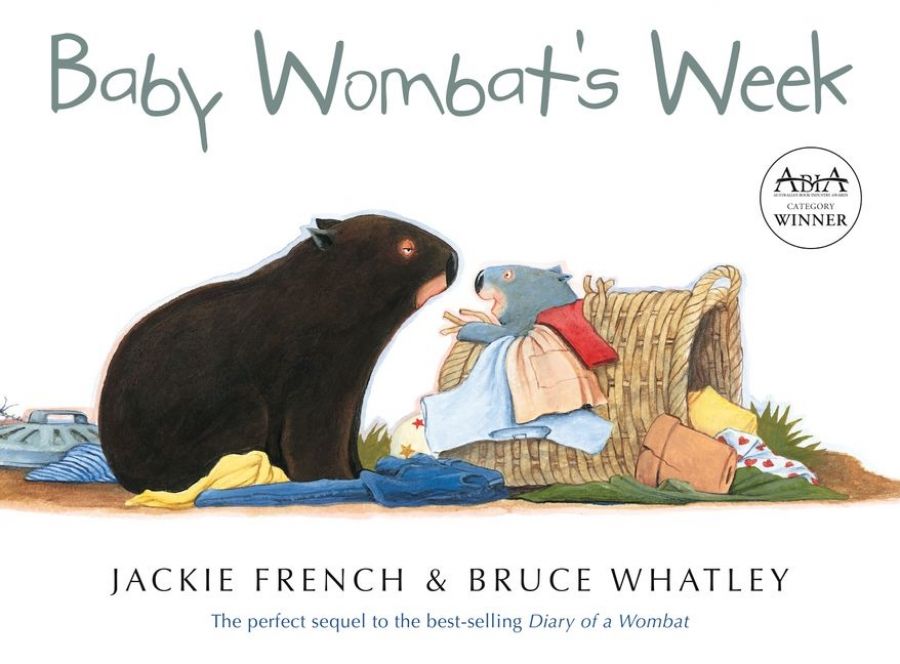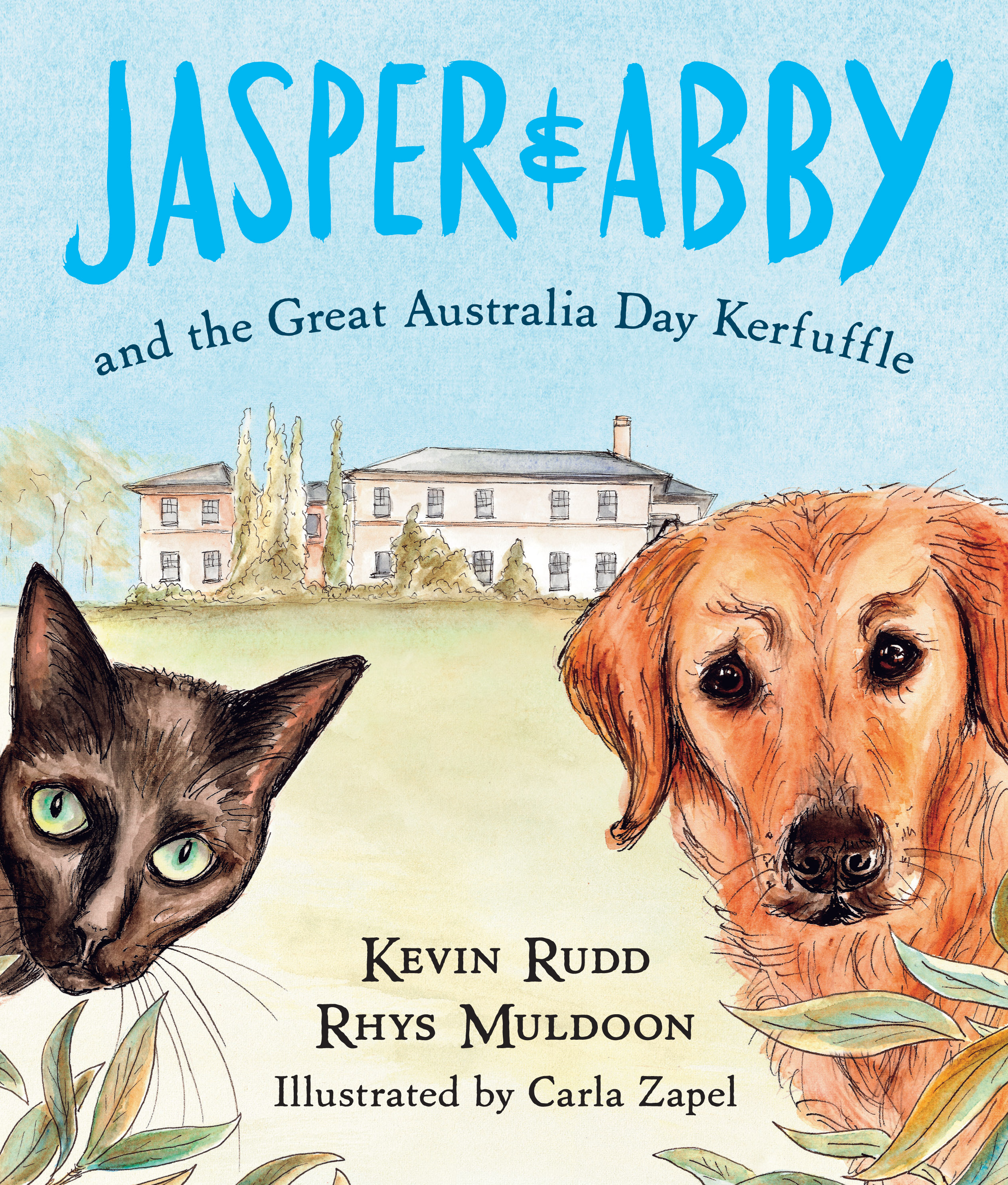
- Free Article: No
- Contents Category: Children's Fiction
- Review Article: Yes
- Article Title: Kerfuffle in the Lodge
- Article Subtitle: Seven new children’s picture books
- Online Only: No
- Custom Highlight Text:
In the 1970s and 1980s many Australian children’s picture books had a distinctly Australian look. The local landscape, flora, and fauna predominated, and unique Australian characters abounded. Today, it is much harder to pick an Australian picture book. Globalisation and market imperatives have led authors to broaden their subject matter, and illustrators have adapted their styles so that a more universal sensibility imbues their work.
- Book 1 Title: Baby Wombat's Week
- Book 1 Biblio: Angus & Robertson, $24.99 hb, 32 pp
- Book 2 Title: Jasper & Abby and the Great Australia Day Kerfuffle
- Book 2 Biblio: Allen & Unwin, $24.99 hb, 24 pp
- Book 2 Cover Small (400 x 600):

Libby Gleeson and Freya Blackwood are award-winning picture book creators who perfectly understand this genre. Gleeson’s text for Clancy & Millie and the Very Fine House (Little Hare, $24.99 hb, 32 pp) is finely honed and structured, with just the right cadences for reading aloud. She sensitively creates a small boy’s world, as Clancy moves from a cosy home in a country town to an imposing terrace house in the inner city. Overwhelmed by the size of the rooms and the loss of everything familiar, Clancy takes refuge in the packing boxes stacked in the backyard. He is soon joined by his neighbour, Millie. Together they build both a very fine house and a very fine friendship.
Blackwood’s beautifully crafted images are a perfect example of modern Australian picture-book illustration at its very best. While the Federation-style cottages that appear in the first double-page spread indicate an Australian setting, her cityscape, with its grey and brown hues, could be in any First World country. Blackwood’s characters are most appealing, and she convincingly portrays the joys of imaginative play. Clancy & Millie is a perfect picture book.
John Hay-Mackenzie’s Cautionary Tales for Boys and Girls (Pier 9 Books, $29.95 hb, 32 pp) has an old-fashioned look, with its decorative font, red cloth cover, and ornately framed image. The well-crafted design suits the traditional nature of cautionary tales – a popular nineteenth-century genre that was successfully parodied by Hilaire Belloc. However, there is something off-putting about the stuffed-toy creatures that appear in this book. There is an unsettling disjunction between their ill-proportioned organic shapes and the elegantly ornate gold frames in which they are displayed, against a background of brightly coloured, striped wallpaper.
These unusual portraits accompany rhyming couplets which record the travails of badly behaved children who get their comeuppance. They include Christopher Jones, who not only threw stones but also swore and littered, and was ultimately squashed by a rubbish truck. There is much to entertain, although Hay-Mackenzie’s tongue-in-cheek verses are sometimes awkwardly expressed, and the weird characters are stilted and expressionless. Older children with a somewhat warped sense of humour may well be drawn to this book.
Little Blue (Little Hare, $19.99 hb, 32 pp), by Gaye Chapman, also has a very traditional feel, with delicate illustrations and stunning blue-and-white endpapers that contrast the two worlds explored in the book: the forest in which Little Blue is lost, and the china platter that is her natural home. The text is at times pedestrian and repetitive; however, while the story is slight, its theme is an important one, and it acts as a perfect vehicle for Chapman’s intricate and old-fashioned paintings. The boy wears a Christopher Robin-style outfit, a blue bird flutters across every page, and the grandmother’s house is picturesquely rustic. This is a tender and sweetly illustrated picture book with fairytale resonances.
Silvio Freytes and Flavio Morais have created an intriguing picture book with In Just One Second (Wilkins Farago, $24.99 hb, 32 pp), a thoughtful exploration of the concept of time. It presents the events that occur simultaneously in one small section of one street, in one city, in one second. It also highlights the way in which we are often connected in surprising ways to the people around us. While the writer of this book is Argentinian and the illustrator Brazilian, the subject matter is universal, as the book encourages children to observe the world around them.
The characters are introduced page by page, with each shown in relation to the person on the street who preceded them. The illustrations are well designed: the orange, yellow, mustard, khaki, and lime palette encourages the eye to concentrate on the figures themselves, which are strongly outlined in dark brown. The result is a book that has a rather 1960s Pop Art feel. The fifteen characters include a baby, a burglar, and a hairdresser. Drama and humour are subtly introduced as the characters parade across the pages, until the final double-page spread shows them all together in their streetscape. While the font used in this book presents some problems – it is all in capital letters, some of which are difficult to read – this unusual picture book still has much to recommend it.
There are no problems with font in The Chicken Thief (Gecko Press, $22.99 hb, 32 pp), a wordless picture book by French illustrator Béatrice Rodriguez. Five characters race across the narrow landscape pages of this totally engaging picture book, as a bear, a rabbit, and a rooster chase a fox that has stolen their friend, a chicken. The illustrations are brightly coloured, in saturated tones of green and brown, and the orange fox and white hen stand out clearly as they sprint through a forest, clamber up a mountain, hide in a cave, climb down onto a beach, sail across the waves and arrive safely at the fox’s den.
While the storyline sounds straightforward, there is far more happening than at first meets the eye. As the chase proceeds, it becomes obvious that the chicken and the fox are becoming friends, something of which the pursuers are not aware, as they desperately attempt to rescue her. Is this a case of Stockholm syndrome, or was the fox lonely rather than hungry when he stole the chicken in the first place? The interpretation is in the hands of the reader, but whatever you decide, it is Rodriguez’s stunning patterned landscapes, engaging characters and wicked sense of humour that make this book such an engrossing read. This delightfully entertaining tale will enthrall readers of all ages. As with all good picture books, it shows how universal visual language can be.


Comments powered by CComment